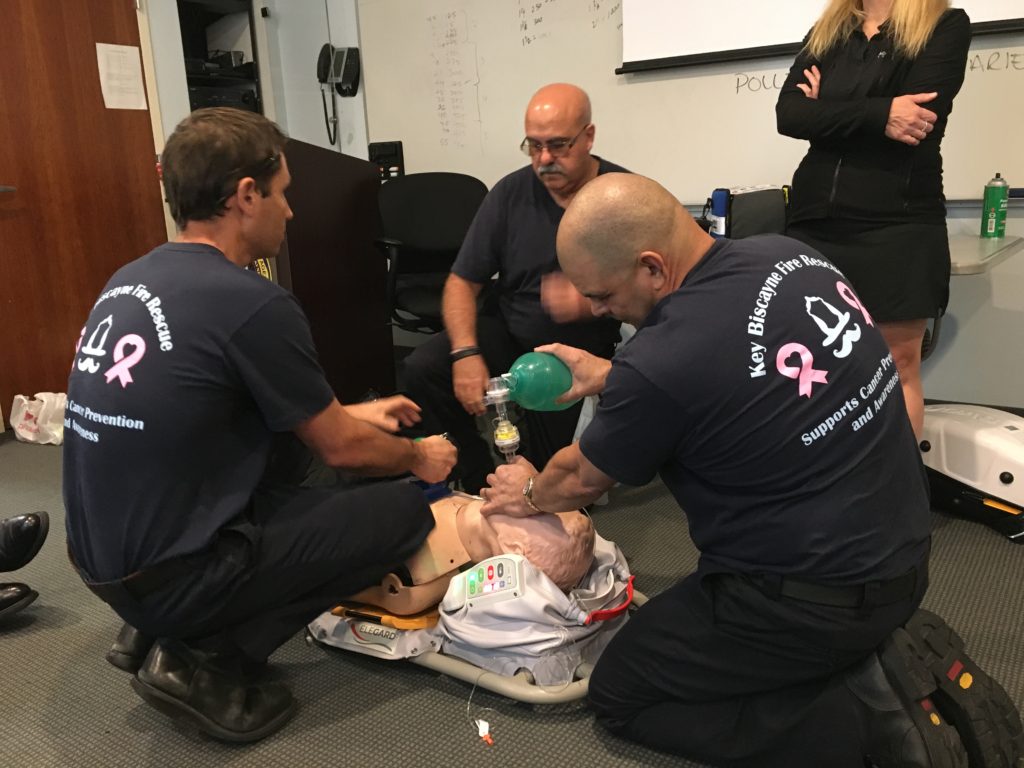Fire Department Blazes a Trail with New Life-Saving Equipment
Annali HaywardOctober 14, 2019

Clinical VP of AdvancedCPR Solutions Kim Marie Macygin looks on as Key Biscayne firefighters practice using the new EleGard system, Oct. 10. Key Biscayne in partnership with the City of Miami is deploying a cutting-edge technology to help improve outcomes for cardiac arrest patients.(Key News-Annali Hayward)
Lieutenant Gary Carter is laughing. His teammates are on the floor, wrestling with a rubber mannequin that won’t cooperate. But despite the cheer, the mission this morning is deadly serious.
They’re still saving lives – just better than before.
The Key Biscayne Fire Rescue department is the sixth agency in the country to implement a cutting-edge new technology: the EleGard “patient positioning” system.

The EleGard Patient Positioning System (AdvancedCPR Solutions)
The team on the floor is simulating a cardiac arrest – one of 500,000 that happen across the United States every year. They go through the moves – “the dance steps” of an organized choreography, says one officer. But after the first two minutes of active chest compression and decompressions, they maneuver something that looks like a pillow and backrest under the doll’s head and torso. Two more minutes of pumping. Then, at the touch of a button, the EleGard starts to slowly tilt the head upward.
Why?
“If you elevate the head, it still allows the brain to receive blood,” explained City of Miami Medical Director Dr. Paul Adams, “but it also lets the blood drain away from the brain, because all that stagnant blood sitting there causes swelling.”
Adams says the EleGard is the final piece of equipment that closes what he calls the “survival loop” – a chain of interventions that aims for the best possible outcome: life. The chain is only as strong as its weakest link, says Adams.
The current rate of ROS (resumption of spontaneous circulation – that is, the rate at which the heart starts beating alone again) is around 25 percent for the City of Miami, including Key Biscayne.
“We’re hoping we increase the quality of CPR by adding this last tool, and get that to the 40 percent area,” said Adams.
Preclinical data show that oxygen delivery to the brain returns to normal levels after 17 minutes of using the EleGard (along with all the other best practice techniques and kit that the Key Biscayne team already have and use as part of the survival loop).
In traditional CPR that measurement tails off. Even with the newer technique of actively decompressing as well as pumping the chest, cerebral perfusion pressure only rises to less than half normal values. So by raising the head (in a timed sequence) to 22 centimeters, oxygen gets to the brain without “banging” it, says Adams.
Back in the training room, Kim Marie Macygin, Clinical VP of AdvancedCPR Solutions – the company that makes the EleGard – evicts the mannequin and hops into the device to help demonstrate.
Macygin is a petite, spirited blonde clearly used to rolling with the banter in a fire department. “You guys are at the cutting edge of this,” she tells them.
Key Biscayne is the second agency in the state to use the EleGard and the first to fully integrate the equipment throughout all battalions (Palm Beach was first, using it in one battalion.
But Fire Rescue Chief Eric Lang said it’s a team effort.
“We’re early adopters, but we’re working in conjunction with the City of Miami on this,” said Lang. “We couldn’t do it without them.”
The department will trial the EleGard for 90 days in the field, and then review with Adams, who said the City of Miami will deploy the EleGard itself in two weeks.
What does an experienced firefighter like Carter think?
“You’ve got to go by the philosophy of the times,” he says. “One thing I’ve learned is that medicine always changes – if this is going to be better for the patients, then great.”


